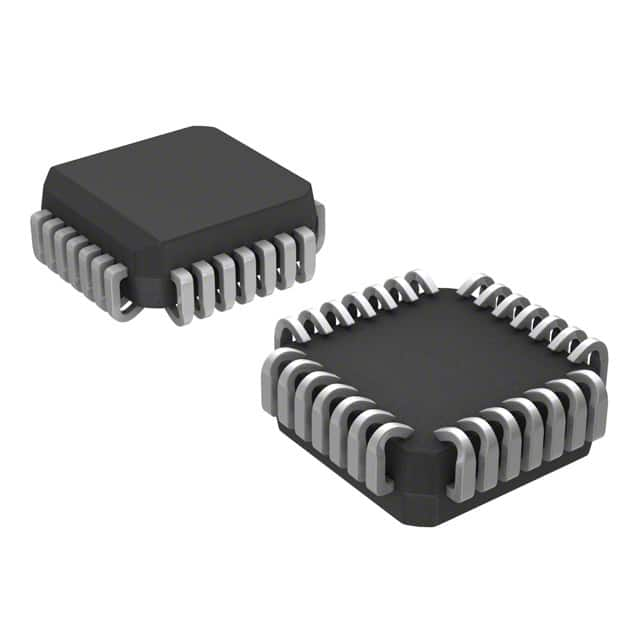MC10E163FNR2
Product Overview
- Category: Integrated Circuit (IC)
- Use: Logic Gate
- Characteristics: High-speed, ECL (Emitter-Coupled Logic) compatible, differential 4-bit binary counter
- Package: 28-pin PLCC (Plastic Leaded Chip Carrier)
- Essence: The MC10E163FNR2 is a high-performance logic gate designed for use in digital circuits that require fast and reliable counting capabilities.
- Packaging/Quantity: The MC10E163FNR2 is typically sold in reels of 250 units.
Specifications
- Supply Voltage Range: -5.2V to -3.8V
- Operating Temperature Range: -40°C to +85°C
- Propagation Delay: 1.5 ns (typical)
- Input Current: ±20 mA (maximum)
- Output Current: ±100 mA (maximum)
Pin Configuration
The MC10E163FNR2 has a total of 28 pins. Below is the detailed pin configuration:
- CLK (Clock Input)
- RST (Reset Input)
- CEP (Count Enable Parallel Input)
- CET (Count Enable Trickle Input)
- Q0 (Output Bit 0)
- Q1 (Output Bit 1)
- Q2 (Output Bit 2)
- Q3 (Output Bit 3)
- VEE (Negative Power Supply)
- GND (Ground)
- Q3B (Complementary Output Bit 3)
- Q2B (Complementary Output Bit 2)
- Q1B (Complementary Output Bit 1)
- Q0B (Complementary Output Bit 0)
- CETB (Complementary Count Enable Trickle Input)
- CEPB (Complementary Count Enable Parallel Input)
- RSTB (Complementary Reset Input)
- CLK (Complementary Clock Input) 19-28. NC (No Connection)
Functional Features
- High-speed operation: The MC10E163FNR2 is designed to operate at high clock frequencies, making it suitable for applications that require fast counting capabilities.
- ECL compatibility: The logic levels of the MC10E163FNR2 are compatible with ECL standards, allowing for seamless integration into existing ECL-based systems.
- Differential inputs and outputs: The device features differential inputs and outputs, which provide improved noise immunity and signal integrity.
- Synchronous counting: The counter operates synchronously with the clock input, ensuring accurate and reliable counting.
Advantages and Disadvantages
Advantages: - High-speed operation allows for efficient counting in time-critical applications. - ECL compatibility enables easy integration into existing ECL-based systems. - Differential inputs and outputs enhance noise immunity and signal integrity.
Disadvantages: - Limited supply voltage range restricts its use in certain power supply configurations. - Higher power consumption compared to some other logic families.
Working Principles
The MC10E163FNR2 is a 4-bit binary counter that utilizes ECL logic. It counts up or down based on the clock input and control signals. The counter can be reset to a specific value using the reset input. The differential inputs and outputs ensure reliable operation even in noisy environments.
Detailed Application Field Plans
The MC10E163FNR2 is commonly used in various applications that require high-speed counting capabilities, such as:
- Digital communication systems
- Data processing units
- Frequency synthesizers
- Test and measurement equipment
- Industrial automation systems
Alternative Models
Below are some alternative models that offer similar functionality to the MC10E163FNR2:
- MC100EP16: 4-bit differential ECL counter
- SN74LV163A: 4-bit synchronous binary counter (CMOS logic)
- CD54HC163: 4-bit synchronous binary counter (TTL logic)
These alternative models can be considered based on specific application requirements and compatibility with existing systems.
Word count: 409
Lista 10 Vanliga frågor och svar relaterade till tillämpningen av MC10E163FNR2 i tekniska lösningar
Sure! Here are 10 common questions and answers related to the application of MC10E163FNR2 in technical solutions:
Q: What is MC10E163FNR2? A: MC10E163FNR2 is a specific type of integrated circuit (IC) that belongs to the MC10E series. It is commonly used in high-speed digital applications.
Q: What are the key features of MC10E163FNR2? A: Some key features of MC10E163FNR2 include differential inputs, high-speed operation, low power consumption, and compatibility with other ECL logic families.
Q: In what types of technical solutions can MC10E163FNR2 be used? A: MC10E163FNR2 can be used in various technical solutions such as telecommunications, data communications, networking equipment, and high-speed data processing systems.
Q: How does MC10E163FNR2 achieve high-speed operation? A: MC10E163FNR2 achieves high-speed operation by utilizing emitter-coupled logic (ECL) technology, which allows for fast switching times and minimal propagation delays.
Q: Can MC10E163FNR2 operate at different voltage levels? A: Yes, MC10E163FNR2 is designed to operate at a supply voltage range of -4.2V to -5.7V, making it compatible with standard ECL voltage levels.
Q: What is the maximum operating frequency of MC10E163FNR2? A: The maximum operating frequency of MC10E163FNR2 is typically in the range of several hundred megahertz (MHz) to a few gigahertz (GHz), depending on the specific application and conditions.
Q: Can MC10E163FNR2 be used in both single-ended and differential signaling applications? A: No, MC10E163FNR2 is specifically designed for differential signaling applications and is not intended for use with single-ended signals.
Q: Are there any specific precautions to consider when using MC10E163FNR2? A: Yes, some precautions include proper decoupling of power supply lines, careful handling to avoid electrostatic discharge (ESD), and following the recommended operating conditions specified in the datasheet.
Q: Can MC10E163FNR2 be used in low-power applications? A: While MC10E163FNR2 is not specifically optimized for low-power operation, it does offer relatively low power consumption compared to other high-speed logic families.
Q: Where can I find more information about MC10E163FNR2? A: You can find more detailed information about MC10E163FNR2 in its datasheet, which is available from the manufacturer's website or through authorized distributors.


